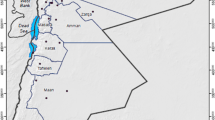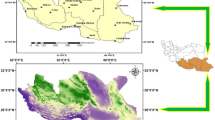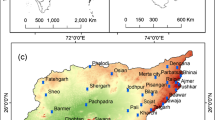Abstract
In this study, the temporal and spatial characteristics of droughts in Iran, including severity, duration, frequency, and extent, were studied using the GPCC-DI, in a 68-year period from 1952 to 2019. To display and analyze these features, time trend components, intensity, duration, and area diagrams, Mann-Kendall non-parametric test and Kriging geostatistical method were used. The result of plotting intensity-duration-frequency maps shows an increasing trend in regional drought severity and spread. It was also found that the most severe droughts occurred in the 12- and 24-month periods from 2000 onward. Mann-Kendall test results also show that significant increases in droughts occurred in the central desert basins of Hamoon basin and south Baluchistan in the southeastern Iran. In addition, decrease in occurrences of dry and wet periods happened in the western, northwestern, and coastal regions of the Caspian Sea. The pattern of spatial variations of drought severity indicated two major drought foci in southeast and central Iran. The number of drought centers in Iran has also increased over time. The results of the analysis of the time trends of dry and wet periods point to the occurrence of continuous droughts in 12- and 24-month periods.






Similar content being viewed by others
References
Abramowitz M, Stegun IA (1965) Handbook of mathematical functions, with formulas, graphs, and mathematical tables. Dover Publications, Mineola, p 1046
Babaee O, Alijani B (2013) Spatial analysis of long duration droughts in Iran. Phys Geog Res Quarterly 85:1–12. https://doi.org/10.22059/jphgr.2013.35831
Doostan R (2020) Analysis of drought researches in Iran (2020). J Spat Anal Environ Hazard 6(4):2–2020. https://doi.org/10.29252/jsaeh.6.4.53
Farajzadeh M, Ahmadian K (2014) Temporal and spatial analysis of drought with use of SPI index in Iran. J Nat Environ Hazards 3(winter 2014):1–16. https://doi.org/10.22111/JNEH.2014.2464
Ghorbani H, Ali Vali A, Zarepour H (2019) Analysis of the climatological drought trend variations using Mann-Kendall, Sen and Pettit tests in Esfahan province. J Spat Anal Environ Hazard 6(2):9. https://doi.org/10.29252/jsaeh.6.2.129
He B, Lü AF, Wu JJ et al (2011) Drought hazard assessment and spatial characteristics analysis in China. J Geogr Sci 21(2):235–249
Jianqing Z, Jinlong H, Buda S, Lige C, Yanjun W, Tong J, Fischer T (2016) Intensity, area and duration analysis of droughts in China 1960–2013. Springer-Verlag, Heidelberg
Keshavarz MR, Vazifedoust M, Fatahi E, Behyar MB (2012) Distribution pattern of direction and intensity of drought changes in Iran using Palmer drought intensity distribution index. J Appl Res Geogr Sci 27:98–101
Livia L, Lukas S, Gunther H (2014) The comparison of the SPI and the SPEI using COSMO model data in two selected Slovakian river basins. EGU General Assembly, Vienna
Mavromatis T (2007) Drought index evaluation for assessing future wheat production in Greece. Int J Climatol 27:911–924
Mishra AK, Singh VP (2010) A review of drought concepts. J Hydrol 391:202–216
Narasimhan B, Srinivasan R (2005) Development and evaluation of soil moisture deficit index (SMDI) and evapotranspiration deficit index (ETDI) for agricultural drought monitoring. Agric For Meteorol 133(1–4):69–88
Parry S, Prudhomme C, Hannaford J, Hughes B (2010) Examining the spatio-temporal evolution and characteristics of large-scale European droughts. BHS Third International Symposium. Managing Consequences of a Changing Global Environment, Newcastle, pp 1–8
Potop, V., and Mozny, M., (2011). The application of a new drought index- standardized precipitation evapotranspiration index in the Czech Republic, ISBN 978-80-86690-87-2.
Tayeb Raziei, Isabella Bordi,·Luis Santos Pereira. (2011). An application of GPCC and NCEP/NCAR datasets for drought variability analysis in Iran. Water Resour Manag 25:1075–1086. DOI https://doi.org/10.1007/s11269-010-9657-1.
Shah, R.; Bharadiya, B.; Manekar, M., (2015). Drought index computation using standardized precipitation index (SPI) method for Surat District, Gujarat, International Conference on Water Resources, Coastal and Ocean Engineering (ICWRCOE 2015) 1243 – 1249
Sheffield, J., Wood, E. F., (2011). Drought: past problems and future scenarios. P. Earthscan, Ed.
Shokoohi A, Morovati R (2014) An investigation on the Urmia Lake Basin drought using RDI and SPI indices. Journal of Watershed Engineering and Management 6(3):232–246. https://doi.org/10.22092/ijwmse.2014.101628
Singh VP, Guo H, Yu FX (1993) Parameter estimation for 3-parameter log- logistic distribution (LLD3) by Pome. Stoch Hydrol Hydraul 7:163–177
Stagge JH, Tallaksen LM, Gudmundsson L, Van Loon AF, Stahl K (2015) Candidate distributions for climatological drought indices (SPI and SPEI). Int J Climatol. Wiley Online Library 35(13):4027–4040
Tallaksen LM, Van Lanen HAJ (2004) Hydrological drought - processes and estimation methods for streamflow and groundwater. In: Tallaksen LM, Van Lanen HAJ (eds) Developments in Water Sciences, vol 48. Elsevier B.V., Amsterdam
Tomros T, Menzel L (2014) Addressing drought conditions under current and future climates in the Jordan River region. Hydrol Earth Syst Sci 18:305–318
Tao H, Gemmer M, Bai YG, Su B, Weiyi M (2011) Trends of streamflow in the Tarim River Basin during the past 50 years: human impact or climate change? J Hydrol 400:1–9. https://doi.org/10.1016/j.jhydrol.2011.01.016
Um J, Kim M, Park Y, Kim D, Jeongbin (2017) Effects of different reference periods on drought index (SPEI) estimations from 1901 to 2014. Hydrol Earth Syst Sci 21:4989–5007
Vicente-Serrano SM, Beguería S, López-Moreno JI (2010) A multi–scalar drought index sensitive to global warming: the standardized precipitation evapotranspiration index (SPEI). J Clim 23(7):1696–1718
Vicente-Serrano SM, Begueria S, Lorenzo-Lacruz J et al (2012) Performance of drought indices for ecological, agricultural, and hydrological applications. Earth Interact 16(10):1–27
World Meteorological Organization (WMO) (2006) Drought Monitoring and Early Warning: Concepts, Progress, and Future Challenges, No: 1006. http://www.wamis.org/agm/pubs/brochures/WMO1006e.pdf
Xu K, Yang DW, Yang HB et al (2015) Spatio-temporal variation of drought in China during 1961–2012: a climatic perspective. J Hydrol 526:253–264
Ziese M, Schneider U, Meyer-Christoffer A, Schamm K, Vido J, Finger P, Bissolli P, Pietzsch S, Becker A (2014) The GPCC drought index – a new, combined and gridded global drought index. Earth Syst Sci Data 6:285–295
Author information
Authors and Affiliations
Contributions
The authors’ participations in the article are as follows:
Conceived and designed the analysis: Yousef Ghavidel and Alireza Hosseini
Collected the data: Alireza Hosseini and Yousef Ghavidel
Contributed data or analysis tools: Manuchehr Farajzadeh, Alireza Hosseini, and Yousef Ghavidel
Performed the analysis: Alireza Hosseini, Yousef Ghavidel, and Ali Mohammad Khorshiddoust
Wrote the paper: Alireza Hosseini
Writing—review and editing: Ali Mohammad Khorshiddoust
Supervision: Yousef Ghavidel
Corresponding author: Yousef Ghavidel
Corresponding author
Ethics declarations
Conflict of interest
The authors declare that they have no conflict of interest.
Additional information
Publisher’s note
Springer Nature remains neutral with regard to jurisdictional claims in published maps and institutional affiliations.
Rights and permissions
About this article
Cite this article
Hosseini, A., Ghavidel, Y., Mohammad Khorshiddoust, A. et al. Spatio-temporal analysis of dry and wet periods in Iran by using Global Precipitation Climatology Center-Drought Index (GPCC-DI). Theor Appl Climatol 143, 1035–1045 (2021). https://doi.org/10.1007/s00704-020-03463-2
Received:
Accepted:
Published:
Issue Date:
DOI: https://doi.org/10.1007/s00704-020-03463-2




